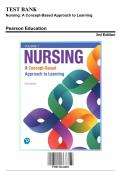Exam (elaborations)
Test Bank for Nursing: A Concept-Based Approach to Learning, 3rd Edition by Pearson Education, 9780134616803, Covering Chapters 1-21 | Includes Rationales
- Institution
- Nursing: A Concept-Based Approach To Learning
- Book
- Nursing
Test Bank for Nursing: A Concept-Based Approach to Learning, 3rd Edition by Pearson Education, 9780134616803, Covering Chapters 1-21 | Includes Rationales
[Show more]



